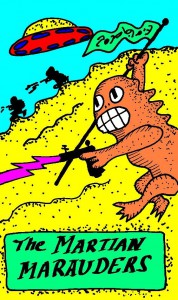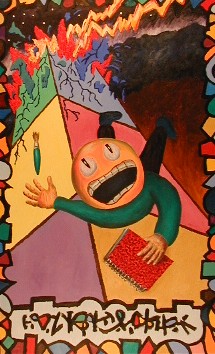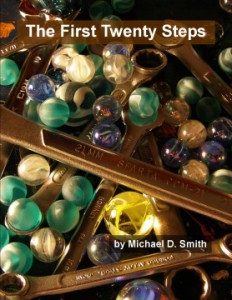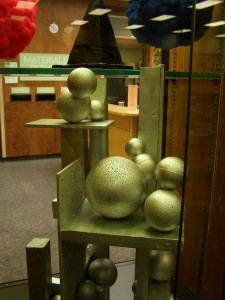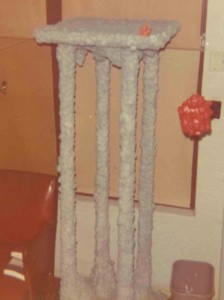Where I’ve been the last two and a half months–not really offering excuses for so few blog posts, but that was one of the outcomes.
The Sculptures Exhibit
In January I set up my exhibit of twelve sculptures at Park Forest Library. I’d already finished a certain dance with sculptures in December, and my 3-D energy seems to be on hold for now, so in a way this exhibit was a bit anti-climatic. But it was satisfying, looked good, and, as with any art exhibit, took a lot of planning time and psychic energy.
The First Twenty Steps Revision and PubIt
On January 28th I finally pushed the button on barnesandnoble.com’s PubIt site that published The First Twenty Steps. It was a good sense of accomplishment, an end to the whole Phase I of getting 20 Steps rewritten, primed for publishing, and put on the site. Organizing my thoughts about the novella and learning the PubIt process has been very good. I’ve been submitting novels to print and e-publishers for a few years now, and though the inevitable series of rejections doesn’t daunt me, this is all an extremely slow process, and I was impatient to put something out there and see what happens. As for Phase 2, I’ve done some initial marketing and will keep experimenting with that effort over time.
The Older Stories Project
I’ve ridden my writer self hard over the past five years, especially accelerating this past year so that most of my novels and novellas have a 2010 or 2011 completion date. I know the positive reason for this: the shocking awareness of how off much of my past writing had been, and the urge to quickly bring it psychically up to date so that I can finally move forward again with an accomplished body of work as a foundation.
In January and February I scanned in the last eight of my older stories and painstakingly proofed them against their original typewritten copies, completing a years-long project of putting all my fiction into digital format. I undertook all these scanning projects both as practical backup and as a hunt for past energies. I think I’ve kept perspective in knowing that the past energies by themselves aren’t really fuel for new creation, but a sort of strengthening of foundations for new exploration.
Here are the story energies:
|
Words |
Pages |
| 33 |
11,800 |
44 |
| Alan Ice on Morningcide Drive |
10,301 |
35 |
| Chapter 32 |
14,018 |
50 |
| Damage Patrol |
15,882 |
59 |
| January 1st |
5,301 |
20 |
| Man Against the Horses! |
12,640 |
45 |
| Oliver |
21,689 |
76 |
| Perpetual Starlit Night |
7,962 |
33 |
| Randy and Laura |
14,712 |
58 |
| Roadblock Zarreich |
4,880 |
19 |
| Space, Time, and Tania |
14,320 |
49 |
| Starvation Levels of the Infinite |
9,292 |
37 |
| Summer Burning City |
1,475 |
6 |
| The 66,000 M.P.H. Bicycle |
9,340 |
24 |
| The Highland Park Cadillac Races |
18,447 |
64 |
| The Selector |
1,551 |
6 |
| Tollhouse |
19,099 |
75 |
| Twenty Years Ago at Darkforce |
9,585 |
43 |
| Where Eagles Have Unfortunately Landed |
12,631 |
46 |
| Zorexians |
23,317 |
78 |
|
238,242 |
867 |
I was surprised to realize that, despite my turning away from the short story form decades ago, I do have 867 pages of (mostly long) stories and that is no small accomplishment. Playing with my spreadsheet, I find that I’ve submitted 357 pages of these as stories to publishers (including the published “Space, Time, and Tania,”) and another 293 have been offered as parts of novels or stories I’ve queried about.
What most of these stories have in common, aside from being too long to be published as stories and too short as novellas, is an urge toward the novel. Many of them are divided into chapters and seek to play out their action on a novel-like stage. They’re not just padded and word wasting. So I think my realization was accurate, during the writing of my first real novel, Akard Drearstone, that I was intended to be a novelist and not a short story writer. The forces behind these stories were longing for novelistic expression all along.
Would I rewrite any of the above stories? I’m doubting that for almost all of them. “Perpetual Starlit Night,” “Starvation Levels of the Infinite,” and “Roadblock Zarreich” are current anyway. “Twenty Years Ago at Darkforce” and “Randy and Laura” might someday fly, an updated “Damage Patrol” as well. But basically I’m looking at these 867 pages as archives. A record of where I’ve been. While I’m committed to taking care of my “writing career” and seeking sane publication where possible, I’m not going to scrape up old stuff hoping to find something to throw out into the publication maelstrom. I have lots of new energies opening up. The spreadsheet above is just an example of some of the foundation work going on.
The Big Paintings Project
In February I did the first of three big paintings, Improvisation Gesture, an experiment in doing a large format, seven feet by eleven feet, on unstretched canvas on the floor. To keep the canvas lightweight and amenable to being rolled, I made the paint layers fairly thin, with none of my usual sand, ceramic stucco, or other texture mediums. The result is more like a tapestry than a typical painting.
Full improvisation was the plan for the first of the three. As I’ve long suspected, the large mural-like size allowed me to spread my restless painting energy over a wide space, avoiding the constant reworking on a smaller canvas into a complicated mess that must eventually be saved from itself. Working on the floor was like sending some urban kid out to a farm to play. There was also a surreal feel of not doing a “real” painting but a theater set “depiction” of a 1950’s action painting.
When I first starting using acrylic paint, my brushstrokes were arbitrary and amateurish. I didn’t even realize this until the mid 90’s, when I saw that paint was really—paint! A physical medium, not just “filling in color blocks.” I then sought texture buildup because I could eliminate the use of brushes, or make their strokes nonapparent in the volcanic buildup of texture. But for the thin paint on the large unstretched canvas I just used paper towels to eliminate all strokes. The final result is “itself.” I can’t say now whether this is an excellent painting or just good practice.
At 77 square feet this is the largest continuous surface I’ve ever done. The 2004 triptych was 75 square feet but in three 25 square-foot paintings. All this isn’t important in terms of impressing myself or others with big numbers, but does highlight the physical challenge of learning how to control such a large space.
I have a couple more paintings planned in this large unstretched format. In the future, I can always stretch these over (big!) frames and even add more texture if I feel like it. Initial showings can be stapled to a wall or affixed with other creative means. The final stretching would lop 5” off all sides and result in an image that looks more or less like the initial one on sortmind.com.
Seven of Cups/Beyond DamnStar
One of the main reasons I wanted to push 20 Steps out and finish the stories, as well as make a solid start on the big paintings project, was so that I could clear some timespace for Seven of Cups/Beyond DamnStar, a new novel I began on January 18th. It’s not autobiographical at all–this is the Jack Commer universe, after all–but pertinent to current concerns, and, in contrast to all the psychically necessary archival work described above, refreshingly up to date.
This is my first new fiction since Ocean Singe Horror in 2008. I’ve never lost confidence in my ability to channel the new stuff. I did much of that throughout all my recent novel revisions, but Seven of Cups was the first numinous blank sheet in quite a while. This blank sheet is much different from starting a journal page or composing an essay or a blog post. And while the novel springs from various little blank sheets of assembled and ruminated notes, the novel itself is somehow completely separate from them.
I can feel a lot lining up behind what I’ve already done. I’m allowing it to be whatever “it wants to be,” and it’s a relief to not have to care about being polished, accessible, or publishable. No query letters or synopses to compose. I feel no need to hurry up and get the project done, though I’m impatient to see how it all turns out. But I recognize that it can’t be pushed like a rewriting project or a scanning/copyediting project. Of course I want it to be an excellent work, but—you just have to take it as it comes.
I have a feeling SOC will crowd out other endeavors for a while.
copyright 2011 by Michael D. Smith


